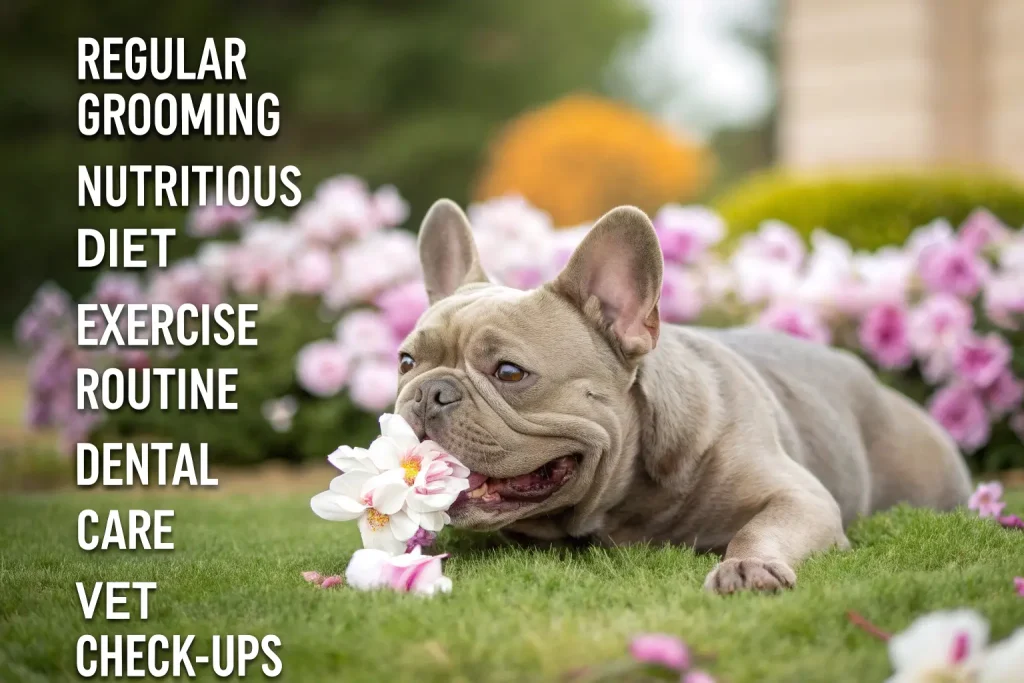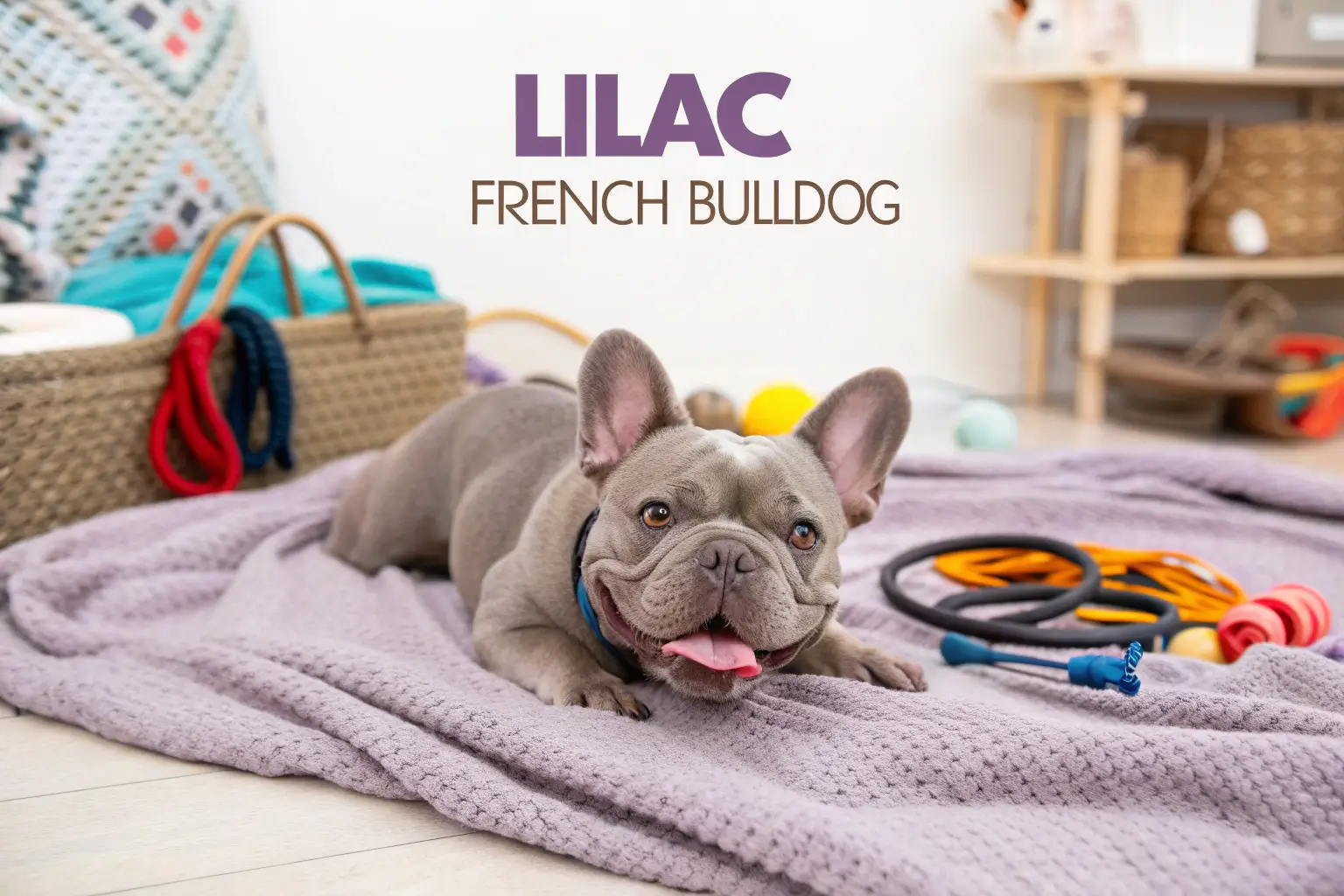How to Care for a Lilac French Bulldog: 5 Essential Tips
Introduction
The lilac French Bulldog, with its distinctive dusty purplish-gray coat and piercing light eyes, has captured the hearts of dog lovers worldwide. This rare color variation of the beloved Frenchie breed requires specific attention and care to ensure they live their happiest, healthiest lives. As a lilac French Bulldog owner, understanding the unique aspects of caring for these special pups isn’t just helpful—it’s essential.
Lilac Frenchies are not just adorable companions with their compact, muscular bodies and characteristic bat ears; they’re also the result of a double recessive dilution gene that affects their coat color, making them one of the rarest and most sought-after French Bulldog varieties. This genetic uniqueness can come with specific health considerations that every responsible owner should be aware of.
Did you know that despite their rarity and distinctive appearance, lilac French Bulldogs share the same lovable, affectionate temperament that makes the French Bulldog the 4th most popular dog breed in America? Their playful yet laid-back personality makes them perfect apartment dwellers and family companions, but their special coloration comes with particular care requirements worth exploring.
Species Overview
Scientific Name: Canis lupus familiaris (domestic dog)
Physical Characteristics: The lilac French Bulldog is a compact, muscular dog with a smooth coat and distinctive bat-shaped ears. What makes the lilac Frenchie special is their dilute bluish-gray coat with a subtle lavender or purplish tint. This rare coloration occurs when a dog carries two copies of the recessive blue (d) gene and two copies of the chocolate/liver (b) gene.
Lilac French Bulldogs typically stand 11-12 inches tall at the shoulder and weigh between 16-28 pounds. They have the characteristic flat face (brachycephalic) of the French Bulldog breed, with expressive round eyes that often appear light blue, gray, or amber. Their short, fine coats have a distinctly smooth texture and a subtle sheen that highlights their unique coloration.
Subspecies: While not technically subspecies, the French Bulldog comes in several color variations beyond lilac, including:
- Blue French Bulldog
- Chocolate/Liver French Bulldog
- Standard colors (fawn, cream, white, brindle)
- “Exotic” colors (merle, platinum, isabella)
The lilac coloration is considered one of the rarest and most valuable in the French Bulldog world, often commanding premium prices from reputable breeders.
Habitat and Distribution
Natural Habitat: As domesticated companion animals, lilac French Bulldogs thrive in home environments. They are particularly well-suited for apartment living due to their small size and moderate exercise needs. These dogs adapt exceptionally well to indoor living conditions and prefer temperature-controlled environments.
Geographic Range: French Bulldogs originated in England in the 1800s before being refined in France. Today, lilac French Bulldogs can be found worldwide, with significant populations in the United States, United Kingdom, France, Australia, and other countries where companion dog breeding is popular.
Adaptations: Lilac French Bulldogs have adapted to live closely with humans as companion animals. However, their brachycephalic (flat-faced) structure means they have specific environmental requirements:
- Poor heat tolerance due to breathing difficulties
- Sensitivity to extreme temperatures
- Limited swimming ability (they tend to sink rather than float)
- Indoor-centric lifestyle preferences
Their compact bodies and minimal exercise requirements make them well-adapted to urban living, though they need protection from extreme weather conditions.
Diet and Feeding Habits
What They Eat: A high-quality diet is crucial for maintaining the health of your lilac French Bulldog. These dogs thrive on premium dog food specifically formulated for small to medium-sized breeds with moderate energy levels. The ideal diet should include:
- High-quality protein sources (chicken, beef, fish)
- Limited grain content (some Frenchies have grain sensitivities)
- Balanced omega fatty acids for healthy skin and coat
- Appropriate calcium and phosphorus levels for bone health
- Controlled calorie content to prevent obesity
Feeding Behavior: Lilac French Bulldogs can be enthusiastic eaters, sometimes eating too quickly and gulping air, which can contribute to digestive issues like gas and bloating. Many Frenchie owners find success with:
- Slow-feeder bowls to prevent rapid consumption
- Scheduled feeding times (typically 2-3 times daily)
- Portion-controlled meals based on age, weight, and activity level
- Limited treats (no more than 10% of daily caloric intake)
Dietary Needs: Due to their genetic makeup and potential for allergies, lilac French Bulldogs may have specific dietary requirements:
Skin and coat support: Their unique lilac coloration comes with more sensitive skin, often benefiting from foods rich in omega-3 fatty acids.
Allergy management: Many French Bulldogs have food sensitivities, with common allergens including chicken, beef, dairy, wheat, and soy. Limited-ingredient diets may be necessary.
Weight management: Frenchies are prone to obesity, which can exacerbate breathing difficulties and joint problems. Carefully measured portions and calorie-controlled food is essential.
Digestive support: Probiotics and easily digestible ingredients may help manage the flatulence and sensitive stomachs common in the breed.
Behavior and Social Structure
Social Behavior: Lilac French Bulldogs are quintessential companion dogs with affectionate, people-oriented personalities. They typically display:
- Strong bonds with their human families
- Moderate to high sociability with familiar people
- Variable tolerance for other dogs (early socialization is key)
- Playful but not hyperactive temperaments
- Adaptable house manners when properly trained
Most lilac Frenchies enjoy being the center of attention and may experience separation anxiety if left alone for extended periods. They generally do well in multi-pet households when introduced properly.
Communication: These expressive dogs communicate through a variety of methods:
- Vocalizations: grunts, snorts, snores, and occasional barking
- Body language: tail wags, ear positions, play bows
- Facial expressions: despite their limited facial mobility compared to longer-muzzled breeds, they communicate clearly with their eyes and overall demeanor
- Physical contact: many Frenchies lean against their owners, sit on feet, or request belly rubs to show affection
Mating and Reproduction: Breeding lilac French Bulldogs requires special consideration:
- Most lilac Frenchies require artificial insemination due to their body structure
- Female Frenchies typically deliver via C-section due to their broad heads and narrow hips
- Ethical breeding practices are essential due to the health challenges associated with color-dilution genetics
- Responsible breeders prioritize health testing for DNA color genetics, hip dysplasia, patella luxation, and cardiac issues
The average litter size is 2-4 puppies, and reproductive management should always be supervised by veterinarians experienced with brachycephalic breeds.
Conservation Status
Endangerment Level: As domesticated pets, French Bulldogs are not endangered in the traditional wildlife conservation sense. However, the extreme breeding for specific traits and colors (including lilac) has raised significant welfare concerns in recent years.
Threats: While not threatened with extinction, the lilac French Bulldog faces several welfare challenges:
- Health issues related to brachycephalic structure: Breathing difficulties, heat intolerance, sleep apnea, and exercise limitations
- Color dilution alopecia: A condition more common in dilute-colored dogs that can cause hair loss and skin problems
- Irresponsible breeding practices: The high market value of lilac Frenchies has attracted unethical breeders who may prioritize color over health
- Genetic concerns: The limited gene pool used to produce the lilac coloration can increase the risk of inherited disorders
Conservation Efforts: Rather than traditional conservation, efforts focus on welfare improvement:
- Responsible breeding programs emphasizing health over extreme physical traits
- Veterinary research into management of brachycephalic obstructive airway syndrome
- Education campaigns about ethical breeding and purchasing practices
- Breed-specific health screening programs
- Advocacy for breeding standards focused on functionality over appearance
Interesting Facts
Genetic rarity: The lilac color in French Bulldogs requires two copies of the recessive blue dilution gene AND two copies of the recessive chocolate gene—a very rare combination.
Color changes: Lilac French Bulldog puppies are often born darker, with their distinctive color developing and lightening as they mature.
Hollywood fame: French Bulldogs, including lilac ones, have been featured in numerous films and TV shows and are popular companions for celebrities, increasing their visibility and popularity.
Ancient ancestry: Despite their modern appearance, French Bulldogs descend from ancient Greek dogs called Molossers, which were later bred with local ratters in England.
Can’t swim naturally: Due to their top-heavy build and short muzzles, lilac French Bulldogs cannot swim without a doggy life vest—their bodies are simply not buoyant enough.
Historical purpose: Unlike many dog breeds developed for hunting or herding, French Bulldogs were bred specifically for companionship during the Industrial Revolution.
Flight restrictions: Many airlines have banned French Bulldogs from flying in cargo holds due to their breathing difficulties and vulnerability to heat stress.
Tips for Caring for a Lilac French Bulldog

1. Temperature Management
Lilac French Bulldogs, like all brachycephalic breeds, struggle with temperature regulation due to their shortened airways. To keep your lilac Frenchie safe and comfortable:
- Keep indoor temperatures between 68-75°F (20-24°C)
- Never leave them outdoors in hot weather (above 75°F/24°C)
- Provide cooling mats and limited outdoor time during summer
- Use doggy sweaters or coats during cold weather
- Schedule walks for early morning or evening during warm seasons
- Never leave them in cars, even with windows cracked
- Watch for signs of overheating: excessive panting, drooling, disorientation, or collapse
Your lilac Frenchie’s breathing limitations make them particularly vulnerable to heat stroke, which can happen much faster than in dogs with normal airways.
2. Skin and Coat Care
The distinctive lilac coat requires special attention to maintain its health and beauty:
- Brush weekly with a soft-bristle brush or grooming mitt
- Bathe monthly with a gentle, hypoallergenic dog shampoo
- Check for signs of color dilution alopecia (patchy hair loss, flaky skin)
- Clean facial wrinkles daily with unscented baby wipes or specialized wrinkle wipes
- Apply dog-safe moisturizer to dry skin patches
- Provide omega-3 supplements if recommended by your veterinarian
- Use limited-ingredient or hypoallergenic products if skin sensitivities develop
- Incorporate regular skin checks into your grooming routine
Lilac Frenchies often have more sensitive skin than standard-colored French Bulldogs. Prompt attention to any redness, itching, or hair loss can prevent more serious skin conditions.
3. Exercise and Weight Management
Proper exercise is crucial for your lilac French Bulldog’s physical and mental health:
- Aim for 20-30 minutes of moderate activity daily, split into shorter sessions
- Focus on low-impact activities like short walks and interactive play
- Avoid exercise during hot or humid weather
- Maintain a healthy weight to reduce strain on breathing and joints
- Use puzzle toys and indoor games during extreme weather
- Monitor breathing during activity and stop at the first sign of labored breathing
- Implement portion control at mealtimes to prevent obesity
- Weigh regularly to detect any unwanted weight gain
- Limit treats to no more than 10% of daily caloric intake
An overweight lilac French Bulldog will face amplified breathing difficulties and joint problems, so maintaining a healthy weight is essential for quality of life.
4. Respiratory Care
The brachycephalic structure of the lilac French Bulldog necessitates special attention to respiratory health:
- Use a harness instead of a collar to avoid tracheal pressure
- Elevate food and water bowls to create a more comfortable eating position
- Consider an air purifier to minimize allergens and irritants
- Maintain a smoke-free home environment
- Monitor for signs of breathing distress (excessive panting, blue gums, exercise intolerance)
- Schedule regular veterinary evaluations of the airways
- Consider consulting with a veterinary specialist about stenotic nares or elongated soft palate if breathing is problematic
- Create a calm, stress-free environment to reduce panting
- Avoid activities that require prolonged exertion
Some lilac French Bulldogs benefit from surgical correction of severe airway issues—have an open conversation with your veterinarian about whether this might benefit your dog.
5. Regular Veterinary Care
Proactive veterinary care is especially important for lilac French Bulldogs:
- Schedule comprehensive check-ups every 6 months
- Stay current on vaccinations and parasite prevention
- Perform early screening for breed-specific issues:
- BOAS (Brachycephalic Obstructive Airway Syndrome)
- Skin conditions including color dilution alopecia
- Intervertebral disc disease
- Hip dysplasia
- Patellar luxation
- Eye problems (cherry eye, entropion)
- Discuss genetic testing to understand potential inherited conditions
- Create a relationship with an emergency vet familiar with brachycephalic breeds
- Maintain detailed health records, including any color-related health concerns
- Consider pet insurance due to the breed’s predisposition to health issues
- Follow a veterinarian-approved dental care routine
With proper veterinary care, your lilac French Bulldog can live a comfortable life despite the breed’s inherent health challenges.
Role in the Ecosystem
Ecological Importance: As domesticated companion animals, lilac French Bulldogs don’t have a natural ecological role. However, they fulfill important social and emotional roles in human society:
- Companionship and emotional support
- Social facilitation (helping owners connect with other people)
- Reducing stress and lowering blood pressure in their human caregivers
- Providing structure and routine to their owners’ lives
Impact of Decline: While not ecologically significant in the traditional sense, the welfare challenges facing extremely brachycephalic dogs like French Bulldogs have prompted discussions about ethical breeding practices. The potential decline in extreme breeding practices would likely improve the overall health and welfare of the breed, even if it meant fewer dogs with the distinctive lilac coloration.
From a broader perspective, the growing awareness of health issues in brachycephalic breeds has sparked important conversations about responsible pet ownership, ethical breeding, and the balance between aesthetic preferences and animal welfare.
Conclusion
Caring for a lilac French Bulldog brings unique joys and responsibilities. Their distinctive appearance and affectionate personality make them wonderful companions, but their special needs require educated, committed owners. By understanding and addressing their temperature sensitivity, skin care requirements, exercise limitations, respiratory challenges, and preventative health needs, you can help your lilac Frenchie live their best possible life.
The rarity and beauty of the lilac coat come with additional health considerations that shouldn’t be overlooked. Responsible ownership means being prepared for potentially higher veterinary costs and making lifestyle accommodations to support their well-being. It also means advocating for breeding practices that prioritize health over extreme physical features.
If you’re fortunate enough to share your life with a lilac French Bulldog, embrace the responsibility of educating others about these special dogs. Help combat irresponsible breeding by supporting efforts to improve breed health and welfare. By doing so, you’ll not only enhance your individual dog’s quality of life but also contribute to a brighter future for the breed as a whole.
Frequently Asked Questions
Is a lilac French Bulldog rare?
Yes, lilac French Bulldogs are among the rarest color variations of the breed. Their distinctive coat color results from the dog carrying two copies of both the blue dilution gene and the chocolate gene—both recessive traits that must be inherited from both parents. This genetic rarity makes them highly sought after and typically more expensive than standard-colored Frenchies.
How much does a lilac French Bulldog cost?
Lilac French Bulldogs typically cost between $5,000-$15,000 from reputable breeders, with show-quality dogs or those with exceptional lineage potentially costing even more. This high price reflects their rarity, the specialized breeding required to produce the color, and market demand. Be cautious of significantly lower prices, as they may indicate unethical breeding practices or misrepresented coloration.
Do lilac French Bulldogs have more health problems?
Lilac French Bulldogs face the same baseline health concerns as all French Bulldogs (breathing difficulties, joint issues, etc.), plus some color-specific challenges. Their dilute coat color makes them more susceptible to color dilution alopecia, a condition causing hair loss and skin problems. Additionally, breeding specifically for rare colors can sometimes reduce genetic diversity, potentially magnifying certain health issues. However, a responsibly bred lilac Frenchie from health-tested parents can be just as healthy as any other French Bulldog.
How long do lilac French Bulldogs live?
The average lifespan of a lilac French Bulldog is 10-12 years, similar to French Bulldogs of other colors. Individual longevity depends greatly on genetics, healthcare, diet, exercise, and management of breed-specific issues. Proper veterinary care, maintenance of healthy weight, and attention to breathing issues can help maximize your lilac Frenchie’s lifespan and quality of life.
Are lilac French Bulldogs recognized by major kennel clubs?
The lilac coloration is not recognized for conformation showing by major kennel clubs like the AKC and UKC. The AKC standard for French Bulldogs recognizes colors including fawn, cream, white, brindle, and combinations of these with white. Lilac (and other colors like blue, chocolate, and merle) are considered “rare” or “exotic” colors and are disqualified in the show ring, though these dogs can still be registered and participate in performance events.







